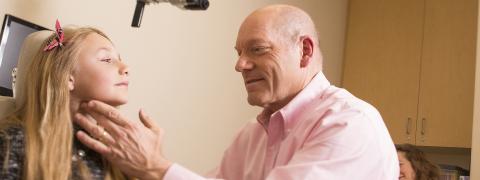
Your head aches. You can’t breathe through your nose. The pressure in your face makes it painful to the touch. And just when you think you’re over it, the symptoms come back — week after week, month after month.
If this sounds like you, you may suffer from chronic sinusitis. The good news? This condition is treatable and advancements have made finding permanent relief easier.
Chronic sinusitis
Chronic or recurrent sinusitis occurs when the cavities in the nasal passage become inflamed and swollen over an extended period and don’t respond to treatment. Mucus is unable to drain, causing breathing problems, headaches and sinus pain.
Allergies and acute sinusitis are often confused with chronic sinusitis. An ear nose and throat doctor (ENT) can determine if you, in fact, have chronic sinusitis or another condition. Effective treatment will serve to alleviate several symptoms:
- Reduce sinus inflammation
- Keep nasal passages draining
- Reduce the number of sinusitis flare-ups
Treatment options
There are several ways to treat chronic sinusitis and help alleviate symptoms.1
- Medication therapy
Nasal corticosteroid sprays are often the first treatment option. These sprays can help prevent and treat inflammation. However, they do not alleviate symptoms for all sinusitis sufferers. If the sinuses have become infected, antibiotics may be necessary. - Immunotherapy
When allergies contribute to the sinus condition, allergy shots (immunotherapy) may help reduce the body's reaction to specific allergens and improve the sufferer’s sinus condition. - Sinus surgery
When medications are ineffective, sinus surgery is an option. In traditional sinus surgery, sinus tissue, polyps, or bone are removed or shaved down to enlarge the sinus opening and promote drainage. - Balloon Sinuplasty
In 2005, Balloon Sinuplasty (BSP) was cleared by the United States Food and Drug Administration as a treatment option for chronic sinusitis. BSP is an endoscopic sinus surgery that gently expands the natural sinus openings using a balloon inserted through a catheter. It requires no cutting or tissue removal and can be performed in your doctor’s office under local anesthesia.
Dr. Paul Manoukian explains how BSP works:
Video animation of the BSP procedure:
Why Balloon Sinuplasty is better
For those with chronic sinusitis, medication therapy often does not alleviate symptoms. While surgery can be effective, the traditional approach is somewhat traumatic to the sinus cavity and requires a lengthy recovery. In studies, Balloon Sinuplasty is shown to deliver immediate and long-lasting relief to patients in a safe and effective manner.2 This minimally invasive procedure also causes less pain and requires a shorter recovery. Importantly, because there is no cutting of nasal bone or tissue, the membranes in the nasal passage that act as mucus sweeper cells are retained and able to continue their natural function clearing out the sinuses.
If you suspect you have chronic sinusitis, see an expert like one of the board-certified ENTs at Sierra Nevada Earn Nose and Throat. They are well-equipped to diagnose and treat any sinus condition, including chronic sinusitis and will explain all your treatment options. Call today to schedule an appointment at 775.883.7666.
1 Mayo Clinic website, Chronis Sinusitis treatment, http://www.mayoclinic.org/diseases-conditions/chronic-sinusitis/diagnosi...
2Efficacy & Outcomes of Balloon Sinuplasty in Chronic Rhinosinusitis: A Prospective Study, US National Library of Medicine, https://www.ncbi.nlm.nih.gov/pmc/articles/PMC3738804/
- Education


